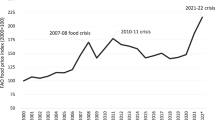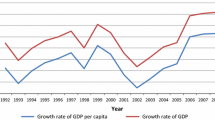Abstract
This study examines how the nutrition transition, which involves a westernization of diets and increased consumption of calorie-dense, processed foods, affects child malnutrition in developing countries. It is often assumed that the nutrition transition affects child weight but not child growth, which could be one reason why child underweight decreases faster than child stunting. But these effects have hardly been analyzed empirically. Cross-country panel regressions show that the nutrition transition reduces child underweight, while no consistent effect on child overweight is found. Against common views, our results also suggest that the nutrition transition reduces child stunting. Further research is required to confirm these findings.
Similar content being viewed by others
References
Ali, D., Saha, K. K., Nguyen, P. H., Diressie, M. T., Ruel, M. T., Menon, P., et al. (2013). Household food insecurity is associated with higher child undernutrition in Bangladesh, Ethiopia, and Vietnam, but the effect is not mediated by child dietary diversity. Journal of Nutrition, 143, 2015–2021.
Asfaw, A. (2008). Does supermarket purchase affect the dietary practices of households? Some empirical evidence from Guatemala. Development Policy Review, 26, 227–243.
Asfaw, A. (2011). Does consumption of processed foods explain disparities in the body weight of individuals? The case of Guatemala. Health Economics, 20, 184–195.
Aslam, M., & Kingdon, G. (2012). Parental education and child health – understanding the pathways of impact in Pakistan. World Development, 40, 2014–2032.
Biesalski, H. K. (1997). Bioavailability of vitamin A. European Journal of Clinical Nutrition, 51, S71–S75.
Black, R. E., Allen, L. H., Bhutta, Z. A., Caulfield, L. E., de Onis, M., Ezzati, M., et al. (2008). Maternal and child under nutrition: global and regional exposures and health consequences. Lancet, 371, 243–260.
Black, R. E., Victora, C. G., Walker, S. P., Bhutta, Z. A., Christian, P., de Onis, M., et al. (2013). Maternal and child under nutrition and overweight in low-income and middle-income countries. Lancet, 382, 427–451.
Brown, K. H., Sanchez-Grinan, M., Perez, F., Peerson, J., Ganoza, L., & Stern, J. S. (1995). Effects of dietary energy density and feeding frequency on total energy intakes of recovering malnourished children. American Journal of Clinical Nutrition, 62, 13–18.
de Haen, H., Klasen, S., & Qaim, M. (2011). What do we really know? Metrics for food insecurity and undernutrition. Food Policy, 36, 760–769.
Desai, S., & Alva, S. (1998). Maternal education and child health: is there a strong causal relationship? Demography, 35, 71–81.
Doak, C.M., Adair, L.S., Bentley, M., Monteiro, C., & Popkin, B.M. (2005). The dual burden household and the nutrition transition paradox. International Journal of Obesity, 29, 129–136.
FAO (2014). Food balance sheets. FAOSTAT data, Rome: Food and Agriculture Organization.
Finucane, M. M., Stevens, G. A., Cowan, M. J., Danaei, G., Lin, J. K., Paciorek, C. J., et al. (2011). National, regional, and global trends in body-mass index since 1980: systematic analysis of health examination surveys and epidemiological studies with 960 country-years and 9.1 million participants. Lancet, 337, 557–567.
Jones-Smith, J.C., Gordon-Larsen, P., Siddiqi, A., & Popkin B.M. (2012). Is the burden of overweight shifting to the poor across the globe? Time trends among women in 39 low- and middle-income countries (1991-2008). International Journal of Obesity, 36, 1114–1120.
Haddad, L. (2013). How should nutrition be positioned in the post-2015 agenda? Food Policy, 43, 341–352.
Hausman, J. A. (1978). Specification tests in econometrics. Econometrica, 46, 1251–1271.
Hawkes, C., Chopra, M., & Friel, S. (2009). Globalization, trade and the nutrition transition. In R. Labonte, T. Schrecker, C. Packer, & V. Runnels (Eds.), Globalization and health: pathways, evidence and policy (pp. 235–262). New York: Routledge.
Headey, D. D. (2013). Developmental drivers of nutritional change: a cross-country analysis. World Development, 42, 76–88.
ICF International. (2013). The DHS program STATcompiler. Retrieved from http://www.statcompiler.com.
IFPRI. (2015). Global nutrition report 2015: actions and accountability to advance nutrition & sustainable development. Washington, DC: International Food Policy Research Institute.
Index Mundi. (2014). Country facts and statistics. Retrieved from http://www.indexmundi.com.
Kimenju, S., Rischke, R., Klasen, S., & Qaim, M. (2015). Do supermarkets contribute to the obesity pandemic in developing countries? Public Health Nutrition, 18, 3224–3233.
Klasen, S. (2008). Poverty, undernutrition, and child mortality: some inter-regional puzzles and their implications for research and policy. Journal of Economic Inequality, 6, 89–115.
McGuire, W., Dyson, L., & Renfrew, M. (2010). Maternal obesity: consequences for children, challenges for clinicians and carers. Seminars in Fetal and Neonatal Medicine, 15, 108–112.
Misselhorn, M. (2010). Undernutrition and the nutrition transition: revising the undernutrition aspect of MDG. Courant Research Center Discussion Paper 35, Goettingen: University of Goettingen.
Planet Retail. (2014). Online retailer market share data. Retrieved from http://www.planetretail.net/DataAnalysis/Interactive.
Popkin, B. M., & Gordon-Larsen, P. (2004). The nutrition transition: worldwide obesity dynamics and their determinants. International Journal of Obesity, 28, S2–S9.
Popkin, B., & Ng, S. W. (2007). The nutrition transition in high- and low-income countries: what are the policy lessons? Agricultural Economics, 37, 199–211.
Popkin, B. M., Adair, L. S., & Ng, S. W. (2012). Global nutrition transition and the pandemic of obesity in developing countries. Nutrition Reviews, 70, 3–21.
Prentice, A. M., & Pau, A. A. (2000). Fat and energy needs of children in developing countries. American Journal of Clinical Nutrition, 72, 1253s–1265s.
Psaki, S., Bhutta, Z. A., Ahmed, T., Ahmed, S., Bessong, P., Islam, M., et al. (2012). Household food access and child malnutrition: results from the eight-country MAL-ED study. Population Health Metrics, 10, 24.
Reardon, T., & Gulati, A. (2008). The supermarket revolution in developing countries: policies for “competitiveness with inclusiveness”. IFPRI Policy Brief 2. Available at http://www.ifpri.org/pubs/bp/bp002.asp.
Reardon, T., Timmer, C. P., Barrett, C. B., & Berdegué, J. (2003). The rise of supermarkets in Africa, Asia, and Latin America. American Journal of Agricultural Economics, 85(5), 1140–1146.
Reardon, T., Timmer, C. P., & Minten, B. (2012). The supermarket revolution in Asia and emerging development strategies to include small farmers. Proceedings of the National Academy of Sciences of the United States of America, 109(31), 12332–12337.
Rischke, R., Kimenju, S. C., Klasen, S., & Qaim, M. (2015). Supermarkets and food consumption patterns: the case of small towns in Kenya. Food Policy, 52, 9–21.
Roemling, C., & Qaim, M. (2012). Obesity trends and determinants in Indonesia. Appetite, 58, 1005–1013.
Semba, R. D., de Pee, S., Sun, K., Sari, M., Akhter, N., & Bloem, M. W. (2008). Effect of parental formal education on risk of child stunting in Indonesia and Bangladesh: a cross-sectional study. Lancet, 371, 322–328.
Smith, L. C., & Haddad, L. (2002). How potent is economic growth in reducing under nutrition? What are the pathways of impact? New cross-country evidence. Economic Development and Cultural Change, 51, 55–76.
Swinburn, B.A., Sacks, G., Hall, K.D., McPherson, K., Finegood, D.T., Moodie, M.L., & Gortmaker, S.L. (2011). The global obesity pandemic: shaped by global drivers and local environments. Lancet, 378, 804–814.
Tessier, S., Traissac, P., Maire, B., Bricas, N., Eymard-Duvernay, S., El Ati, J., et al. (2008). Regular users of supermarkets in greater Tunis have a slightly improved diet quality. The Journal of Nutrition, 138(8), 768–774.
Timmer, C.P. (2009). Do supermarkets change the food policy agenda? World Development, 37, 1812–1819.
UNICEF. (1998). The state of world’s children: focus on nutrition. New York: Oxford University Press.
UNICEF, WHO, & World Bank. (2012). UNICEF-WHO-World Bank joint child malnutrition estimates. Retrieved from http://www.who.int/nutgrowthdb/estimates/en/.
Victora, C. G., Adair, L., Fall, C., Hallal, P. C., Martorell, R., Richter, L., et al. (2008). Maternal and child under nutrition: consequences for adult health and human capital. Lancet, 371, 340–357.
Vollmer, S., Harttgen, K., Subramanyam, M. A., Finlay, J., Klasen, S., & Subramanian, S. V. (2014). Association between economic growth and early childhood under nutrition: evidence from 121 demographic and health surveys from 36 low-income and middle-income countries. Lancet Global Health, 2014(2), e225–234.
WHO. (2000). Obesity: preventing and managing the global epidemic (WHO Technical Report Series No. 894). Retrieved from http://whqlibdoc.who.int/trs/WHO_TRS_894.pdf?ua=1.
WHO. (2006). WHO child growth standards: length/height-for-age, weight-for-age, weight-for-length, weight-for-height and body mass index-for-age: methods and development. Geneva: World Health Organization.
World Bank. (2014). World development indicators. Retrieved from http://data.worldbank.org/data-catalog/world-development.
Acknowledgments
This research was financially supported by the German Research Foundation (DFG).
Author information
Authors and Affiliations
Corresponding author
Appendix 1
Appendix 1
Rights and permissions
About this article
Cite this article
Kimenju, S.C., Qaim, M. The nutrition transition and indicators of child malnutrition. Food Sec. 8, 571–583 (2016). https://doi.org/10.1007/s12571-016-0566-x
Received:
Accepted:
Published:
Issue Date:
DOI: https://doi.org/10.1007/s12571-016-0566-x







